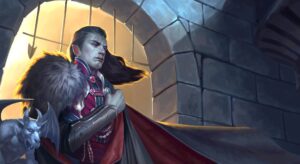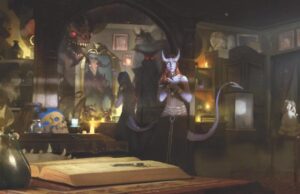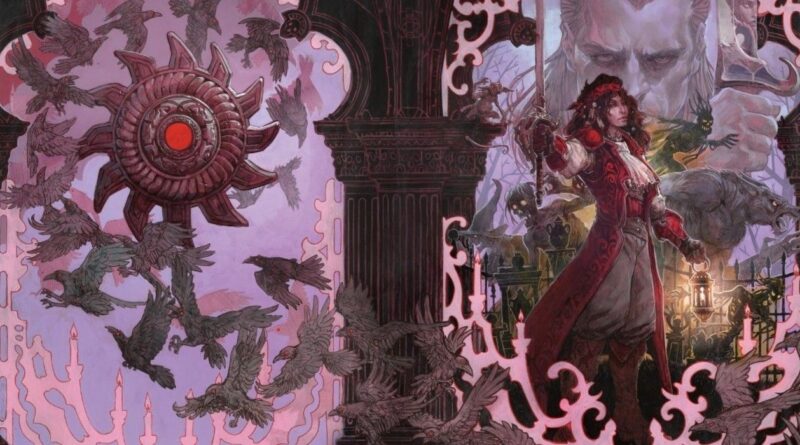RPG Review: Van Richten’s Guide to Ravenloft
Van Richten’s Guide to Ravenloft is everything Patricia Pulling and the rest of the 1980’s Satanic Panic crowd warned us about. Full of blood-drinking, seances, fortune-telling cards and spirit boards, they would have had a complete heyday with this book. And I love it.
Centered around both the lands of Barovia and the rest of the Domains of Dread, Van Richten’s walks DMs through the various settings that make up the lands as well as helping you flesh out how to run horror in D&D.
 Let’s start with what the Domains of Dread are. They are created by the Dark Powers, unknowable and unknown entities who have created the Domains as prisons for the Darklords, who are “the seed from which a thorny thicket blooms.” Each Domain is centered on a Darklord, and the Domain exists as an extension of that lord’s psyche, plaguing and torturing them with reminders of their failures. They don’t even realize they are prisoners, or that the whole world centers around them. Often blinded by their own ambition and torment, they are kept within the Domain by their vices. The most famous of these Darklords is Strahd Von Zarovich of castle Ravenloft.
Let’s start with what the Domains of Dread are. They are created by the Dark Powers, unknowable and unknown entities who have created the Domains as prisons for the Darklords, who are “the seed from which a thorny thicket blooms.” Each Domain is centered on a Darklord, and the Domain exists as an extension of that lord’s psyche, plaguing and torturing them with reminders of their failures. They don’t even realize they are prisoners, or that the whole world centers around them. Often blinded by their own ambition and torment, they are kept within the Domain by their vices. The most famous of these Darklords is Strahd Von Zarovich of castle Ravenloft.
Each Domain is both unique and finite, some smaller than a city. They exist within the plane of Shadow, but may at times touch the material plane as mists form, pulling unwary travelers within. Perhaps the party is traveling down the road as a fog settles. They come up over a hill and see a city and coast laid out before them down below. “There shouldn’t be a city there… or a coastline…” Or perhaps in their travels, mist shrouds the road, until they can make out a light and realize there is a carnival in the distance. Domains of Dread can be found anywhere, and are not easy to escape once you have been claimed.
I’m focusing on the Domains here, because they’re my favorite parts. Each one is VERY unique. Some are continental in size with dozens of cities, enough to run an entire campaign in. One is collapsing in on itself because of the death of the Darklord. Often, the Darklord isn’t the person you assume it to be, but someone manipulating the person who appears in charge.
Kalakeri stands out to me, because it’s not even particularly scary on the outside. Themed on India and set around a tropical rainforest, there are multiple cities. The Royal family rules never everything, and there is all kinds of intrigue and betrayal. The true horror comes from the power of the family, and how they hunt for traitors everywhere. It is “trapped in an unbreakable spiral of suffering and hate.” Horror here is found in power and those who wield it with nothing to stop them. The Domain has Renown rules governing it, with different factions giving you different benefits, which can also harm you with other factions. It’s a really cool setting, and I’d love to run a one-shot here.
 The book has a few new options for character creation. The book explores the concept of heroes who are haunted, and how they came to find themselves in the mists. The new Lineages are Dhampir (a half-vampire) who can Spider Climb and has a Vampiric Bite they can use to regain HP. The Hexblood is created by ancient magic or infused with hag’s blood. They can take a piece of their body, such as a fingernail or hair, and telepathically message or remote view where it is, and can use a small bit of hex magic. Finally, there’s the Reborn, who can either be a standard Frankenstein’s Monster, or simply resurrected after death. They get lots of features that you’d expect from an undead, and can try to get glimpses into their past for skill check bonuses.
The book has a few new options for character creation. The book explores the concept of heroes who are haunted, and how they came to find themselves in the mists. The new Lineages are Dhampir (a half-vampire) who can Spider Climb and has a Vampiric Bite they can use to regain HP. The Hexblood is created by ancient magic or infused with hag’s blood. They can take a piece of their body, such as a fingernail or hair, and telepathically message or remote view where it is, and can use a small bit of hex magic. Finally, there’s the Reborn, who can either be a standard Frankenstein’s Monster, or simply resurrected after death. They get lots of features that you’d expect from an undead, and can try to get glimpses into their past for skill check bonuses.
New subclass options include the Bard’s College of Spirits, where you act as a conduit for ghosts and spirits (perfect for playing a spirit medium). At sixth level they can conduct seances, which is pretty cool and flavorful. The other subclass is the Warlock’s Undead patron. They draw their powers from such entities as Acererak or Kas the Bloody-Handed. They are able to frighten their enemies with their visage, and even untether their spirit from their body to astrally project themselves.
 The book explores all the different kinds of horror you can play with, from Dark Fantasy, to Cosmic Horror, from Folk Horror to Slasher Horror. Many of these genres have a list of the different monsters from both this book as well as the Monster Manual that fit right into the genre.
The book explores all the different kinds of horror you can play with, from Dark Fantasy, to Cosmic Horror, from Folk Horror to Slasher Horror. Many of these genres have a list of the different monsters from both this book as well as the Monster Manual that fit right into the genre.
The book concludes with a 3rd level adventure, The House of Lament. I particularly love this adventure because I myself ran some players through my own House of Lament using room boards from Betrayal at House on the Hill a few years ago. Basically, the house itself is its own domain, and is ALIVE. It’s a lot of fun, and has lots of opportunity to be VERY creepy.
I highly recommend you add this one to your shelves. I wasn’t even particularly interested in running a horror game myself until sitting down and reading this book. Now I can think of little else.
Wizards of the Coast sent a copy of Van Richten’s Guide to Ravenloft to Dice Monkey for review.


Pingback: Routinely Itemised: RPGs #101